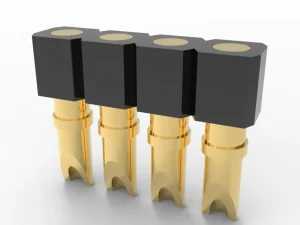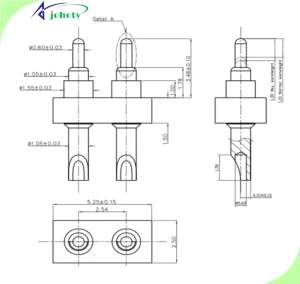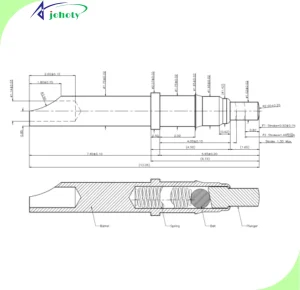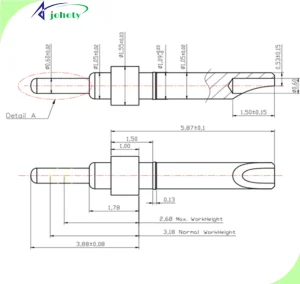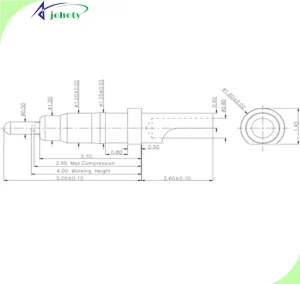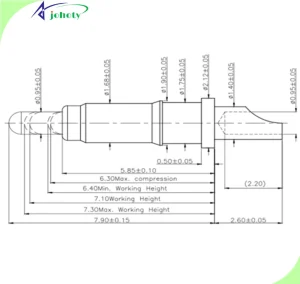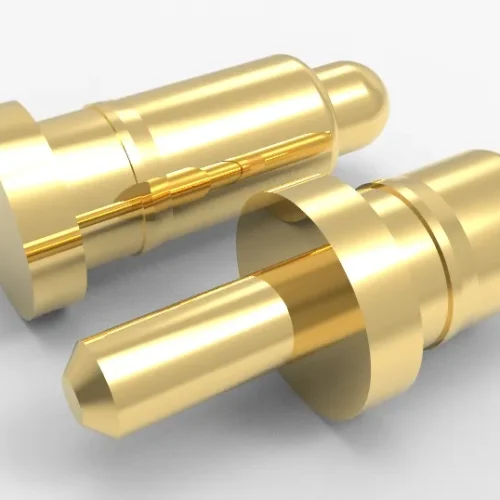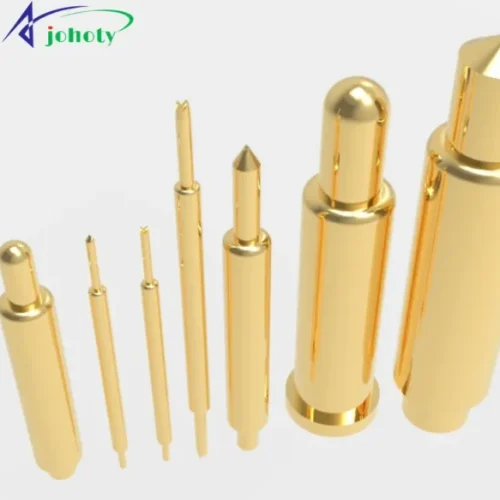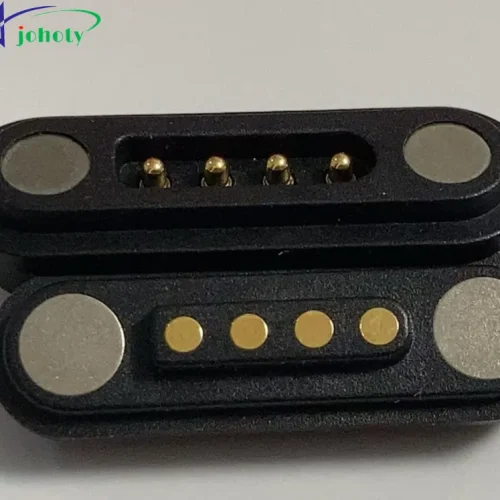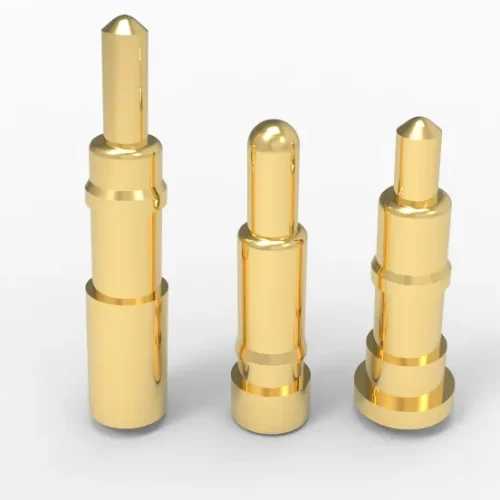Solder Cup Pogo Pin for UAVs and EVs, 5μm Gold Plating, 50A High Current, Stable Power and Signal Transfer in Demanding Environments. Custom Design Available Now.
Introduction: How stable can the solder cup pogo pin be in extreme environments?
Solder cup pogo pins are commonly used in UAVs or EVs. Because it can support situations with severe voltage and current transients, limited space, and extremely strong vibrations. And it can avoid any instability or small mistakes, ensuring that there are no system-level fatal failures.
We need a connector that doesn’t come off the chain, said a European electric vehicle battery pack manager at the testing site. And he was referring to today’s protagonist: the solder cup pogo pin.
Solder cup pogo pins were previously considered only for testing fixtures. And now, it is becoming a new key component in high reliability electrical systems. Johoty will take you step by step to understand how the solder cup pogo pin stands out in high vibration, high current, and high reliability environments. And why Johoty’s pogo pin connector is worth your deep attention.
What is a solder cup pogo pin? Not just spring loaded pin
Let’s start with the terminology itself: pogo pin is commonly referred to as spring loaded pin. Essentially, it is a connecting component that forms reliable conductivity through precision spring crimping.
Solder cup refers to a cup-shaped solder pad at the end of the pogo pin. Used for directly soldering wires instead of surface mount, through hole pogo pin insertion, and other methods. It is suitable for complex limited space, concentrated wiring harnesses, and severe vibrations.
In other words, it is a high-precision combination of traditional test probe structure and aerospace-grade wire harness technology. The goal is to be stable, reliable, and easy to deploy.
Why is the solder cup pogo pin becoming increasingly indispensable in UAVs and EVs?
High current demand in EVs: why 50A is not an excess, but just enough?
In typical EV BMS or fast charging modules, the instantaneous current can reach 30-6A. Even communication modules or drive units often require redundancy with peak currents above 20A.
At 50A current:
- Ordinary pins may generate heat >40℃ due to excessive contact resistance.
- Solder pads are prone to fatigue, virtual soldering, and even erosion.
- Micro oxidation of the contact surface can directly cause voltage instability or communication interruption.
The Johoty 50A solder cup pogo pin can continuously power on for 8 hours at 25℃. After testing, the surface temperature rise does not exceed 22℃. This indicates that it not only withstands the load, but also has a low contact impedance of 10mΩand high thermal stability.
Solder cup pogo pin naturally adapts to high vibration and high density in UAVs
The drone flight control module, gimbal system, and power distribution board are one of the most densely populated and feared areas for electronic modules. And these areas are often accompanied by:
- Small volume+multi axis vibration (simultaneous oscillation in X, Y, Z directions).
- Frequent disassembly and assembly (insertion and removal required for each test and maintenance).
- Rapid deployment requirements (cannot be repeatedly wired).
Traditional solder pins or plug-in connectors have the following issues:
- Vibration causes stress accumulation in solder joints, resulting in a significant decrease in reliability after prolonged flight.
- Insertion and removal wear the contact surface, causing poor contact.
- Large space is required and cannot be close to onboard core components.
And the solder cup pogo pin has the following natural advantages:
- The internal preloading structure of the spring maintains its compressive force continuously under vibration.
- Adapt to custom shells or metal nesting, easily achieve waterproof, dustproof, and anti-drop design.
- The solder cup interface can directly bind the wire harness without the need for complex PCB end interfaces, greatly saving onboard space.
Johoty’s solder cup pogo pin adopts a bidirectional limit structure. It can avoid bias deformation and ensure a continuous conductivity of >95% under ± 4G vibration testing.
Significance of 5μm-thick gold plating process: not only expensive but also a weapon for long-lasting antioxidant warfare
You may say: Isn’t thicker gold plating just more expensive? But in reality behind this, it is a long-term reliability issue:
In EV and UAV systems, connectors are often in a micro current or micro signal state. For every 10mΩ increase in contact resistance, the communication quality may decrease several times. The thicker the gold plating layer, the lower the risk of failure caused by oxidation, scratches, and wear.
Comparative experiment (Johoty Laboratory, Q4 2024)
| Gold-plating Thickness | Original Contact Resistance | Contact Resistance after 100,000 Mating |
|---|---|---|
| 1μm | 8.1mΩ | 42.5mΩ(Significant deterioration) |
| 3μm | 7.9mΩ | 23.2mΩ |
| 5μm | 7.7mΩ | 9.8mΩ(Almost unchanged) |
You can find long-life cycle applications, where a 5μm-thick gold plating is the critical point from usability to stability.
Reliable transmission of current and signal, deep value of solder cup structure
In modern modular electronic systems, connectors often need to achieve:
- High current power supply (driver, lamp, main control).
- Small signal transmission (sensor feedback, communication protocol).
Conventional design requires the coordination of two types of interfaces, which can easily lead to wiring redundancy, signal interference, or timing drift. The solder cup pogo pin naturally has:
- Internal multi-stage structure, supporting customized independent current and signal segmentation.
- Metal shell can serve as a shielding end to reduce crosstalk.
- Solder cup end supports direct bonding of differential signal lines to ensure impedance continuity.
Actual case of Johoty shows that solder cup pogo pin works in a load-bearing drone power module. After using the pogo pins, the overall EMC test noise decreased by about 17.4%.
Customization is Key: Customization is not about parameters, it’s about system integration
The most common concern raised by Top Manufacturer customers is not whether the specifications are correct, but whether they can adapt to my system. The biggest advantage of solder Cup pogo pin is its highly customizable nature:
- Pogo pin length adjustable: supports 4.60mm~46.00mm (the length requested by most clients).
- Spring force options: 0.15N~5.0N, suitable for different contact pressure scenarios.
- Customize housing with ABS, PEEK, metal, nylon, and others, with accompanying shielding layers or buckle structures.
EV customer currently served by Johoty (a Tier 1 electric drive system manufacturer in Germany) has provided feedback: Yes, we have customized Johoty’s solder cup pogo pins. We have reduced 33% of inter-module wiring redundancy and shortened the assembly time of the entire machine by 1.2 hours.
This is where customization is not just about changing a parameter, but a pivot for system optimization.
Solder cup pogo pins must withstand everything
Johoty conducted the following tests and verifications for each pogo pin:
| Test Items | Test Conditions | Results |
|---|---|---|
| Constant current test | 50A, continuous for 8 hours | No significant change in contact resistance (<0.5m Ω) |
| High and low-temperature cycling | -40°C ↔ 125°C,50 times | good contact, elastic and fatigue-free |
| Plug and unplug lifespan | 10,000 times,2 times per second | contact resistance increase <2mΩ |
| Vibration test | 10~2000Hz,±4G,3-axis 12 hour | conductivity>95%, no structural damage |
| Salt spray corrosion | 96 hours | coating is intact, can’t see obvious spot corrosion |
| Solder resistance test | Solder temperature 350 ℃, time 8s | no cracks in the solder cup, no splashing |
These data are the underlying basis for determining whether the solder cup pogo pin can truly work in extreme applications.
Conclusion: Don’t view the solder cup pogo pin with a consumer goods mindset anymore. It is the lifeblood of your system
You can choose housing colors for aesthetics, but you cannot compromise on indicators such as current, resistance, vibration, and lifespan just to ensure they are sufficient. At Johoty, we don’t take pride in doing well, but rather in being reliable even in the most extreme scenarios for our customers. We do not provide standardized parts, we provide solder cup pogo pins that cannot be killed in your scenario.
If you happen to be worried about power connection, signal stability, structural compression, and vibration reliability. Alternatively, your UAV and EV products are currently facing a design bottleneck in the last mile. Please feel free to contact us. Johoty is definitely a trusted manufacturer of solder cup pogo pins.


